(A Merry May Yesterday to you all! But before I begin, let me confess that I have gathered information for this article from the work of others, and the relevant webpages/sites are listed in the text and at the end.)
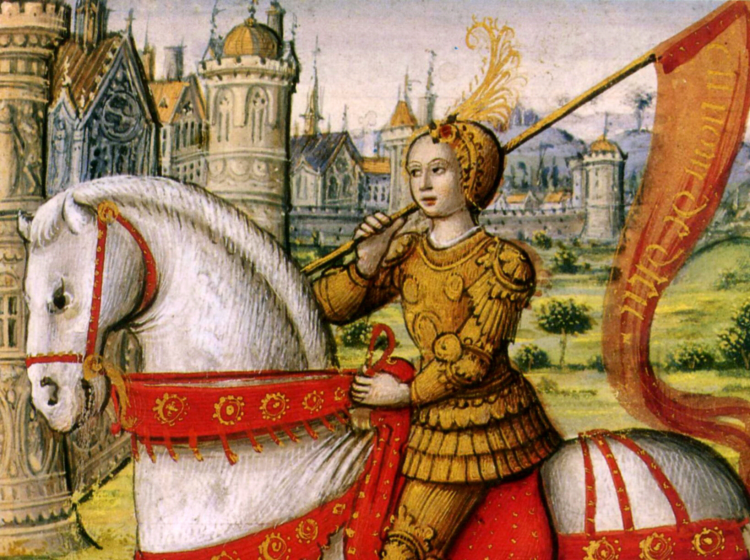
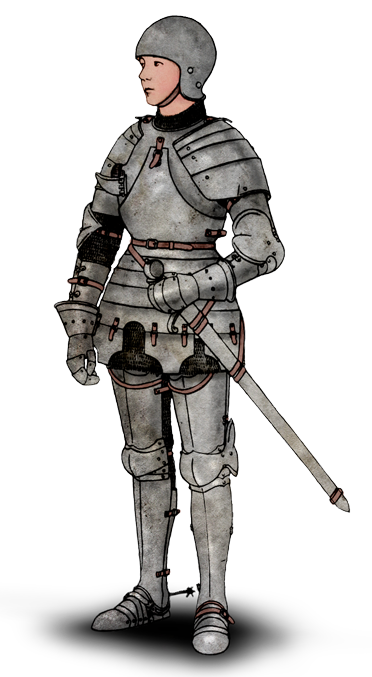
Yes, one of the above illustrations is of Joan of Arc, perhaps the most famous cross-dresser in history. The other is from http://io9.gizmodo.com/what-kind-of-armor-did-medieval-women-really-wear-1502779338. The point of including these pictures is that they show woman in armour. That is, a woman in traditionally male fighting attire. Bear this in mind as you read on.
As the title of this article suggests, I wish you to imagine the following. A May Day tournament is in progress somewhere in 14th century England. It is a glorious day, with the fresh green leaves of late spring, and all the flowers of the season in full bloom. Children dance around a maypole, a fair is doing roaring business, as are hawkers, ale tents, pie-sellers and all the other traders who feature at such events.
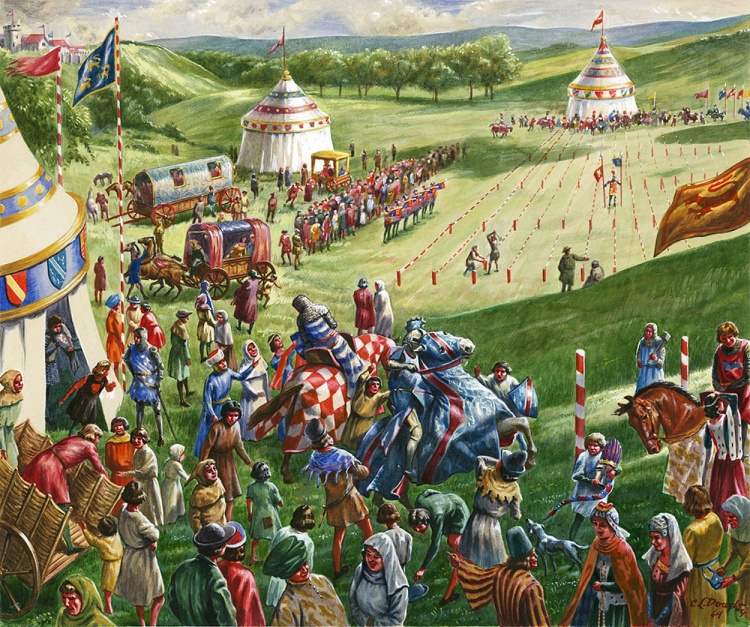
Colour is a feast for the eye, and everyone, including the populace, is in their best clothes. Banners stream, music plays, polished armour shines, hooves thud, weapons clash, and the crowds cheer. Heralds announce their lords, blacksmiths’ hammers clang, and trumpets blare.
Clad in their costly armour and riding their richly caparisoned coursers, the knights enter the field. Each one is preceded by his squire, riding the courser and carrying his master’s crested helm and lance. Next comes the lord himself, in gleaming jousting armour, on foot, led on a golden chain by a lady on a palfrey. She wears her knight’s colours, as does the squire, and the courser is similarly garbed. Behind the lord come his minstrels. Finally, the lord mounts his great horse, making it prance and toss its head to show off his horsemanship. All is ready for the jousting to commence.
There are few spectacles more popular than this, and everyone from the surrounding towns and villages have flocked to watch the flower of nobility meet in ferocious combat.
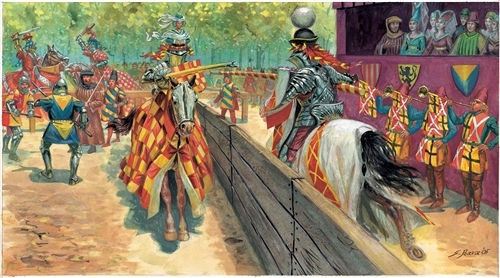
Then, all of a sudden, the proceedings are interrupted, as reported in a complaint by Knighton in Chronicon: “…troops of ladies attended, sometimes as many as 40 or 50, dressed up in all sorts of extraordinary masculine attire. They were young, beautiful, and wealthy. They acted so bold that they were often called rude. They dressed in “diverse and wonderful male apparel, in parti-colored tunics, with short caps and bands wound round the head, and girdles bound with gold and silver, and daggers in pouches (scabbards?) across their body…they paraded about the lists on carefully chosen chargers or equine beasts of some other well-groomed kind, ruining both their bodies and their fortunes by their wanton and scurrilous behaviour…But they neither fear the anger of God nor blush at the comments of God-fearing citizens…” Good heavens above! I knew nothing of all this.
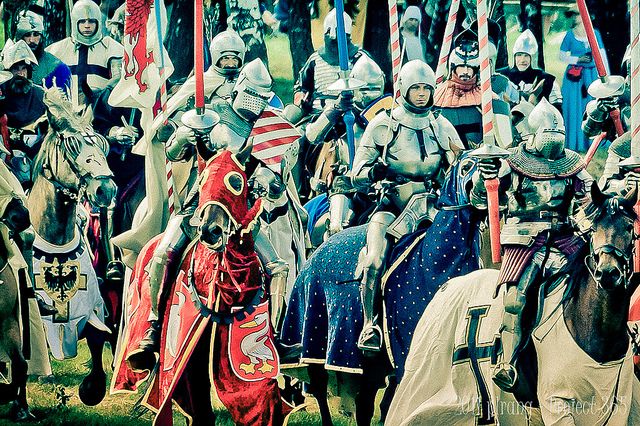
(Please pretend these are beautiful ladies – I fear our medieval Amazons did not leave a picture for posterity!)
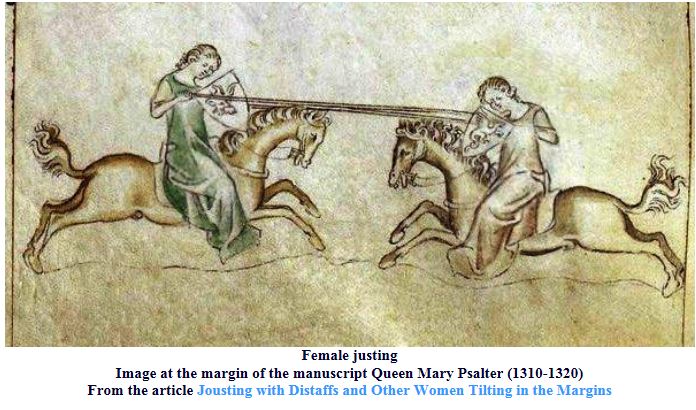
Tournaments were the sole preserve of the men; women were there to adorn the proceedings and gaze longingly at their chosen knights. Right? Well, wrong—if the above quote from Knighton is correct.
The two pictures above show us how women were usually seen at jousts. On the left is how we always imagine them, watching and sighing over their heroes. One such hero is the dazzling fellow on the right, who is—wait for it—Ulrich von Liechtenstein! Yes, for fans of the film “A Knight’s Tale”, starring the late Heath Ledger, such an Ulrich really did exist! But in the 13th century, not the 14th, as depicted in the film. The point of including Ulrich here is that on his helm he wears a large, warlike Venus. I have seen other illustrations where Venus is baring all. https://en.wikipedia.org/wiki/Ulrich_von_Liechtenstein
Above right is a drawing of women in men’s clothing, but above left it is men dressed as women. It seems that the latter situation often occurred at tournaments, and that for jousting men wore their armour beneath female clothes. They took part in hastiludes with the best of their opponents, eventually hurling aside their gowns to display their true masculine metal…er, mettle. So, looking at the illustration below, who is to say that it really is a woman carrying the distaff? Might “she”, at any moment, metamorphose into a burly knight who’ll be no pushover?
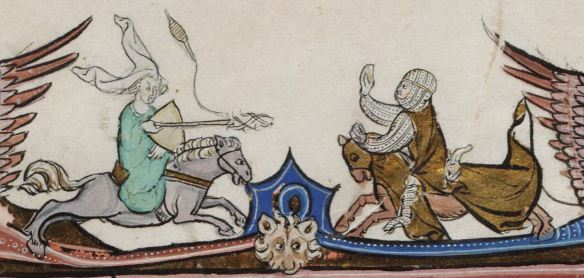
A “female” knight triumphantly revealing himself to be a man was apparently quite acceptable. But, the other way around…? I don’t think it ever happened, but what if, after achieving some notable points against an opponent, a “knight” changed into a woman? I doubt the poor defeated fellow, shamed for having been bested by a female, would ever recover. A soft lot, men, eh?
In the thesis indicated at the end of this article, the following passage is quoted. It concerns events in a French medieval tale entitled “Berengier au Long Cul”:
“Though the husband is a man and is knighted, he is not from noble blood and therefore the wife, though being a woman, can more easily succeed as a knight than he can. She has true chivalry running in her veins, and this is the reason that she is attested to be able to convince her husband that she is a valiant, successful knight. As he is not, he does not accept the knightly code and refuses to joust valiantly, instead submitting himself to the humiliation that his wife forces onto him.”
So, in order to carry off the pretence with any hope of success, the woman in question had, at the very least, to be of knightly blood. Anything less and she would fail abysmally. These tournament cavalcades of ladies dressed as men were therefore all blue-blooded.
To sum it up, I turn to Gael Stirler at http://stores.renstore.com/feminism-fashion-and-cross-dressing-in-the-14th-and-15th-centuries#.WNJgG7msmTN where it is stated that there was indeed a short-lived female tournament maiden movement (no further mention after the 14th century):-
“A century before Joan of Arc put on armor, cross-dressing women were not as rare as you may think. The clothing styles for men and women were similar except for length and headgear. Women occasionally wore short tunics when riding or traveling abroad on foot, as much for comfort as safety. Popular romances and saint’s biographies contained stories of young women who wore masculine disguises to move about society with the freedom of men. They wore men’s clothing as a sign of their celibacy, and willingness to defend it. Some even fell in love with women in these stories.
“Even earlier, Galvano della Flamma described “Amazons of Milan with golden girdles and hard masculine hearts” who wore masculine clothing in public. So it seems that there was a loosely organized, secular, feminist movement, perhaps fashion based, in the 14th century. Since little was written about it in its time, this movement probably had no strong leaders or role models, no philosophy like the Beguine movement, and seemed to only attract women when they were young.
“What we can surmise from these descriptions is that this wasn’t a few naughty girls who showed up at one or two tournaments but that it had to have been a movement made up of many well-born ladies who travelled all over to attend tournaments. They were not combatants, but were, somehow, allowed to parade with the knights on the list field. Imagine 40 or 50 beautiful ladies wearing elegant short tunics covered with embroidery, edged in fur, with glittering belts of gold and silver, their heads topped with marvelous liripipe chapeaus, all of them riding large, beautifully groomed horses. It would be a sight worth traveling to see.”
Indeed it would!
Hmm…and then there was the rise of the May Day Robin Hood plays. I suppose, Robin and his merry friends were chaps…weren’t they?
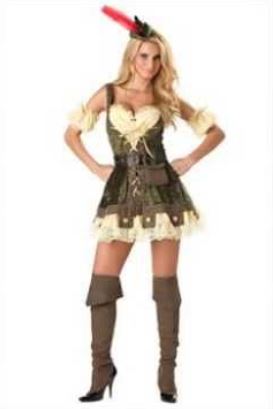
References:-
For medieval female cross-dressing, there is information at the following additional sites.
http://sourcebooks.fordham.edu/halsall/source/1395rykener.asp
http://www.fscclub.com/history/joust-e.shtml
For a thesis on the subject of female cross-dressing in general, go to
And for information about May Day itself, look at https://medievalisterrant.wordpress.com/2013/04/30/may-day-in-the-middle-ages/,
Further references:
Lewis, Katherine J. et al, editor, Young Medieval Women, St. Martin’s Press, New York, 1999.
References about Tournament Maidens:
Brook, Iris, English Costume from the Early Middle Ages Through the Sixteenth Century Dover Publications, Mineola, 2000 reprint of 1936 original.
Newton, Stella Mary, Fashion in the Age of the Black Prince:A study of the years 1340 to 1365, Boydell Press/Rowman & Littlefield, Suffolk, 1980.





4 comments